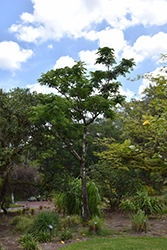Fri & Sat 8am - 8pm
Sun 8am - 7pm
Anytown, USA 12345
fax: 261.787.0463
e-mail: info@successgc.com


Plant Finder

Japanese Prickly Ash
Zanthoxylum ailanthoides
Height: 60 feet
Spread: 30 feet
Sunlight:
![]()
![]()
Hardiness Zone: 8a
Other Names: Ailanthus-leaved Pepper Tree
Description:
A graceful, ornamental tree that makes a great landscape accent or screen; elegant, pinnate, glossy green foliage is dense and fern-like; nice yellow fall color; size can be easily controlled with pruning; young leaves are used in Taiwanese cuisine
Ornamental Features
Japanese Prickly Ash has attractive green deciduous foliage which emerges gold in spring on a tree with an upright spreading habit of growth. The crinkled pointy pinnately compound leaves are highly ornamental and turn yellow in fall. It features subtle corymbs of chartreuse flowers in early summer. The mottled brown bark adds an interesting dimension to the landscape.
Landscape Attributes
Japanese Prickly Ash is a deciduous tree with an upright spreading habit of growth. Its average texture blends into the landscape, but can be balanced by one or two finer or coarser trees or shrubs for an effective composition.
This is a relatively low maintenance tree, and is best pruned in late winter once the threat of extreme cold has passed. It has no significant negative characteristics.
Japanese Prickly Ash is recommended for the following landscape applications;
- Accent
- Shade
- Hedges/Screening
Planting & Growing
Japanese Prickly Ash will grow to be about 60 feet tall at maturity, with a spread of 30 feet. It has a high canopy of foliage that sits well above the ground, and should not be planted underneath power lines. As it matures, the lower branches of this tree can be strategically removed to create a high enough canopy to support unobstructed human traffic underneath. It grows at a medium rate, and under ideal conditions can be expected to live for 60 years or more.
This tree does best in full sun to partial shade. It prefers to grow in average to moist conditions, and shouldn't be allowed to dry out. This plant does not require much in the way of fertilizing once established. It is not particular as to soil type or pH. It is highly tolerant of urban pollution and will even thrive in inner city environments. This species is not originally from North America.
